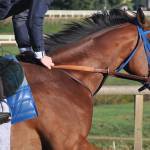When Second Place is a Benefit for Racehorses

A research project conducted at RMIT Platform Technologies Research Institute in Australia has suggested that slipstreaming, or running behind another horse, can reduce the aerodynamic drag produced as a racehorse pushes through the air.
Using small but detailed models of horses and jockeys in wind tunnel tests, the researchers found that a jockey can reduce drag on his horse almost 40% by following one other horse. If he has two horses in front of his horse, the trailing horse meets 66% less drag. Conversely, however, in a line of five horses running side by side, the middle horse has to work somewhat harder because drag increases by 25% on the animal in this position.
Theoretically, slipstreaming could help a horse conserve his efforts in the early part of the stretch run, leaving enough energy to surge past the leader as they approach the wire. In reality, many factors influence the way horses place in a race, and while slipstreaming probably won’t hurt a horse’s chances of winning, it is unlikely to guarantee a trip to the winner’s circle.








